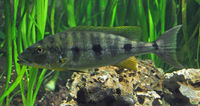Difference between revisions of "Boulengerochromis microlepis"
From The Aquarium Wiki
m |
|||
| Line 36: | Line 36: | ||
|max_water_hardness=12 | |max_water_hardness=12 | ||
}} | }} | ||
| − | + | ||
| − | + | == Origin == | |
| − | + | :Endemic to Lake Tanganyika. | |
| − | + | ||
| − | + | ||
| − | + | == Sexing == | |
| − | + | :Mature females are significantly smaller than males. | |
| − | + | ||
| − | + | ||
| − | + | == Tank compatibility == | |
| + | :Due to this fish's size it's best either kept in pairs or singly in species tanks. It can occasionally be combined with other large-growing Tanganyikan Cichlids. Large peaceful yet robust bottom-dwellers may also work. | ||
| + | |||
| + | |||
| + | == Diet == | ||
| + | :Should accept most meaty foods including high quality Cichlid pellets, as well as shrimp, earthworms and silversides. | ||
| + | |||
| + | |||
| + | == Feeding regime == | ||
| + | :Feed once or twice a day. | ||
| + | |||
| + | |||
| + | == Environment specifics == | ||
| + | :Requires hard alkaline with a pH 8.0 or above. Tank décor is not important as long as it's sturdy and a sand substrate is preferred. Needs a substantial amount of swimming space. | ||
| + | |||
| + | |||
| + | == Behaviour == | ||
| + | :A generally peaceful fish to those of similar size, but will eat smaller fish. They are increasingly territorial to their own species as they mature. | ||
| + | |||
| + | |||
| + | == Identification == | ||
| + | :Said to be one of the largest African Cichlids in existence. The body is long with a yellow-green base colour, with faint vertical dark green lines running down from the dorsal fin, these get darker as the fish ages. The head is speckled with blue spots. | ||
| + | |||
| + | |||
{{Categories | {{Categories | ||
|Category=Fish, Fish (Freshwater), Cichlids, Cichlids (African), Cichlids (Lake Tanganyika) | |Category=Fish, Fish (Freshwater), Cichlids, Cichlids (African), Cichlids (Lake Tanganyika) | ||
Latest revision as of 02:49, 13 December 2017
Giant Tanganyika Cichlid
Boulengerochromis microlepis
946 Litres (250 US G.)
60-90 cm (23.6-35.4")
Freshwater
8.0 - 9.0
24 -26 °C (75.2-78.8°F)
8-12 °d
1:1 M:F
5-10 years
Family
Cichlidae
Contents
Additional names
- Giant Tanganyika Cichlid, Giant Cichlid
Additional scientific names
- Tilapia microlepis, Paratilapia microlepis
Origin[edit]
- Endemic to Lake Tanganyika.
Sexing[edit]
- Mature females are significantly smaller than males.
Tank compatibility[edit]
- Due to this fish's size it's best either kept in pairs or singly in species tanks. It can occasionally be combined with other large-growing Tanganyikan Cichlids. Large peaceful yet robust bottom-dwellers may also work.
Diet[edit]
- Should accept most meaty foods including high quality Cichlid pellets, as well as shrimp, earthworms and silversides.
Feeding regime[edit]
- Feed once or twice a day.
Environment specifics[edit]
- Requires hard alkaline with a pH 8.0 or above. Tank décor is not important as long as it's sturdy and a sand substrate is preferred. Needs a substantial amount of swimming space.
Behaviour[edit]
- A generally peaceful fish to those of similar size, but will eat smaller fish. They are increasingly territorial to their own species as they mature.
Identification[edit]
- Said to be one of the largest African Cichlids in existence. The body is long with a yellow-green base colour, with faint vertical dark green lines running down from the dorsal fin, these get darker as the fish ages. The head is speckled with blue spots.
Pictures[edit]
Video[edit]
| Juveniles: | |
External links[edit]
- Fishbase (Mirrors:
 )
)
